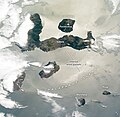
Size of this preview: 617 × 600 pixels. Other resolutions: 247 × 240 pixels | 494 × 480 pixels | 720 × 700 pixels.
Original file (720 × 700 pixels, file size: 432 KB, MIME type: image/jpeg)
File history
Click on a date/time to view the file as it appeared at that time.
| Date/Time | Thumbnail | Dimensions | User | Comment | |
|---|---|---|---|---|---|
| current | 16:44, 8 September 2021 |  | 720 × 700 (432 KB) | Tillman | {{Information |Description=Galapogos Islands: Sunglint helps tease out features that are not often visible. This photograph, taken by an astronaut from the International Space Station, offers a peek at several of the Galápagos Islands, visible between cloud cover and accented by sunglint on the ocean surface. The sunglint helps reveal features that are usually hard to spot, such as the lake occupying the summit caldera of La Cumbre, the shield volcano that makes up Fernandina Island. The you... |
File usage
The following pages on the English Wikipedia use this file (pages on other projects are not listed):
Global file usage
The following other wikis use this file:
- Usage on mr.wikipedia.org
- Usage on uk.wikipedia.org

